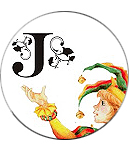
The Jester
It’s pretty obvious what the jester has to do with wit … but perhaps less obvious to some what he has to do with wisdom. But the key point of the jester figure in European history is that he encapsulated both things … wit and wisdom … and he was held in special regard as the king’s mentor, not just to make him laugh, but far more importantly to speak the truth. In ancient Europe, the jester was seen as the only person who could ‘gainsay the king’ … gainsay meaning ‘speak against’, or in other words, argue with him. The most famous such figure in English mythology is, of course, Merlin, adviser to King Arthur.
Virtually all human societies and cultures have an equivalent figure in their mythology as well as in practice. They all accept the value to any society of having a person within it who is objective and thus able to comment truthfully as an observer. In the modern western world, these people are often our comedians … who we allow to say things most people would avoid … to bluntly speak the truth. Thus … there is wisdom in wit.
Such figures are known by many names in many cultures … shaman, sage, medicine man, wizard, magus, jester … the list goes on. But what they all share in common is that they live both ‘within and without’ their society … physically in it, of course, but objectively distanced in a way that empowers them to see it like it is and tell it like it is.